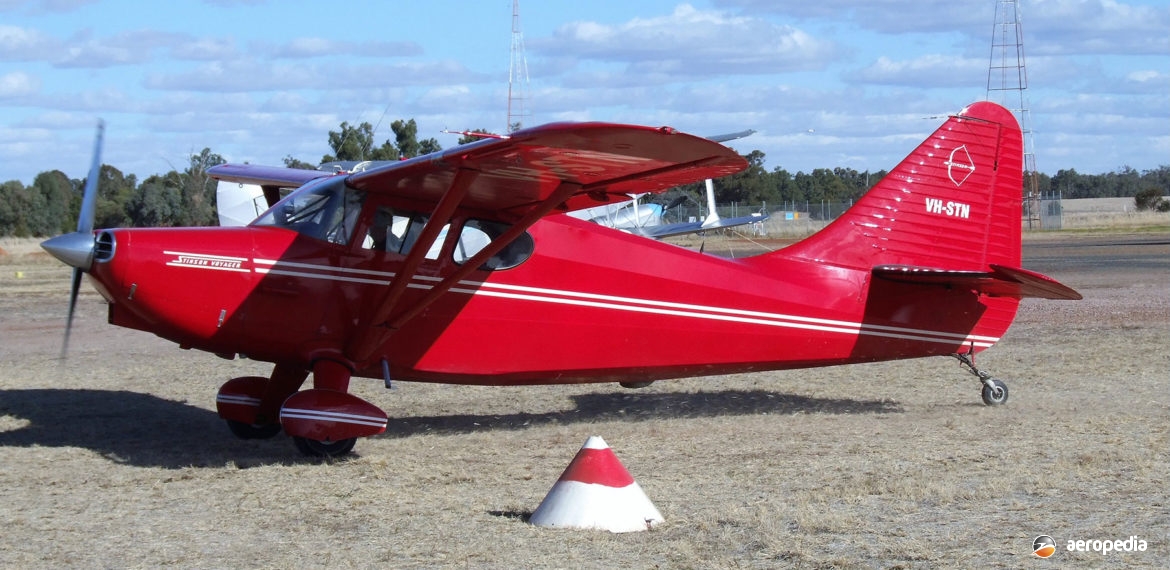Photograph:
Stinson 108 Voyager VH-STN (c/n 108-3-4267) at Narrandera, NSW in April 2006 (David C Eyre)
Country of origin:
United States of America
Description:
Four-seat cabin monoplane
Power Plant:
(108-3)
One 123 kw (165 hp) Franklin 6A4-150-B3 six-cylinder in-line air-cooled engine
Specifications:
- Wingspan: 10.3 m (33 ft 11 in)
- Length: 7.7 m (25 ft 2 in)
- Height: 2.3 m (7 ft 6 in)
- Wing area: 14.4 m² (155 sq ft)
- Max speed at sea level: 235 km/h (146 mph)
- Cruising speed at 75% power at 1,524 m (5,000 ft): 209 km/h (130 mph)
- Stalling speed clean: 100 km/h (62 mph)
- Stalling speed with flaps: 89 km/h (55 mph)
- Initial rate of climb: 235 m/min (770 ft/min)
- Service ceiling: 4,267 m (14,000 ft)
- Range: 892 km (554 miles)
- Endurance: 4½ hours
- Fuel capacity: 189 litres (42 Imp gals)
- Take-off run to 15 m (50 ft): 427 m (1,400 ft)
- Landing run from 15 m (50 ft): 457 m (1,500 ft)
- Empty weight: 587 kg (1,294 lb)
- Useful load: 490 kg (1,080 lb)
- Loaded weight: 1,089 kg (2,400 lb)
History:
Edward Stinson in 1926 formed Stinson Aircraft with a facility at Willow Run in Detroit to build aircraft. This Company was developed as the Stinson Aircraft Division of the Aviation Manufacturing Corporation and introduced a three-seat cabin monoplane, known as the Model 105 Voyager, to its range in 1939. In 1940 the Company introduced the Model 10 to the range with a 60 kw (80 hp) Continental engine and transferred production to Nashville in Tennessee. The Model 10 in 1941 became the Model 10A with a 67 kw (90 hp) Franklin engine. About 500 were completed before World War II, at which time production to meet military contracts took over.
After the war production resumed in 1946, the new model being the 108 with a 112 kw (150 hp) Franklin engine. Various materials were used in construction. The fuselage was fabric-covered welded chrome-molybdenum steel tube, and the wing was built with spruce spars and aluminium alloy ribs, also fabric covered. The type became quite popular, and the Stinson Sentinel liaison aircraft and air-observation post was developed from it.
The Model 108 was a scaled-up post-war development of the earlier models. Seating four, it was initially fitted with a 112 kw (150 hp) Franklin 6A4-150-B31 engine but, as development progressed, this was replaced by a series of more powerful engines. The first was the Model 108-1, and this was superseded in 1948 by the Model 108-2 with the 123 kw (165 hp) Franklin 6A4-165-B3 unit. At the same time the utility model Station Wagon was introduced. This model differed in that the floor was stressed to carry a heavier load. The next model, introduced in 1948, the 108-3, had an increased vertical tail area and an enlarged fuel tank. Subsequently, because of the flood of ex-military aircraft on to the market, Stinson sold the rights to the Voyager, and 500 un-sold aircraft, to the Piper Aircraft Company of Lock Haven, Pennsylvania on 1 December 1948. A small number of aircraft were manufactured by that organisation until production ceased in 1950.
Univair Aircraft Corporation in Colorado supplied replacement parts for the Stinson 108 series for many years and, because of expected problems with parts supply in the long term, obtained certification to fit a 149 kw (200 hp) Avco Lycoming IO-360-A1A or 134 kw (180 hp) Avco Lycoming O-360 engine to replace the original Franklin engine. Eagle Flightways of Hillsboro in Oregon at one stage marketed a kit to convert the type to take the 172 kw (230 hp) Continental O-470 engine.
First of the type in this region was VH-AKH (c/n 108-5115), initially registered in December 1955. It became VH-AKI in November 1958 but was written-off after a crash at Western Junction, TAS, on 24 September 1960. The Model 108 Voyager has become very popular in recent years and eighteen examples are known to have been imported to Australia, including five Model 108-1s, four 108-2s and nine 108-3s.
Australian examples surviving include VH-ROA (c/n 108-5215), VH-STN (c/n 108-3-4267), VH-BPS (c/n 108-4709), VH-NWK (c/n 108-5084) and VH-IOB (c/n 108-4384). A further example became VH-NNK³ (c/n 108.2190 – ex N9190K, NC9190K) on 4 May 2018.
A few have been imported to New Zealand and these include: ZK-VGR (c/n 108-2317), ZK-NCC (c/n 108-3752) and ZK-STN (c/n 108-3585).

